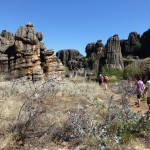
We jounced along a half kilometer or so, feeling the road deteriorate as we went, unsure whether we were supposed to be there or should turn back. A few 4WD vehicles passed by, their drivers uncertain as we were where to go, but with the vehicle to handle it. Eventually, a driver in the opposite direction affirmed we were on the right track, so we kept going till a dusty parking lot where a few other vehicles sat.
We were hours from the tiny Western Australian towns of Hall’s Creek and Fitzroy Crossing along the Great Northern Highway, at the gate to the Mimbi Caves, a place few tourists know about unless they ask the right questions at a tourist info site. The night before we had “freedom camped” with our campervan up on a bluff just five kilometers away, a spot well maintained by the highway people (To read our post on campervanning, click here). No one else staying there had ever heard of these caves.
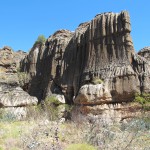
Bumping along past the gate, in our guide’s 4WD, led us to an array of imposing eye-catching limestone rock formations, looking as if they were clawed by giant bears.
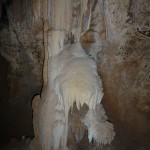
The caves proved to be somewhat less interesting than we expected. What we could explore were dead caves (i.e. no longer forming carbonate structures inside), with some remnants of formations and curtain walls to remind of the old glories. Nonetheless, we fully enjoyed the teasing of color from the stone walls as light filtered into open sections of the caves. In other parts, intricate, rock-strewn passageways and twisting routes kept us entertained.
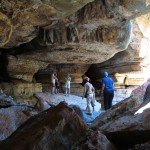
The greater value of being here, however, was that at last after a number of guided tours in the Northern Territory and WA, a member of the Gooniyandi tribe was our guide. For over a week we had been visiting land returned to its “traditional owners” over the last few decades, then leased back to the national Parks department so visitors could come and see the spectacles of the area. But where, we wondered, were the members of the indigenous tribes like those we saw doing tours at Mossman Gorge near Cairns?
It’s still true that a large portion of the indigenous population lives in this area, many now resident in the few cities and towns, rather than on their traditional lands. Sadly the aboriginals most tourists see are often lounging about the streets or grouped in the shade of park trees, as perhaps their ancestors might have done during the day’s heat in the outback. The inevitable impression from their clothing and behavior is, however, one of poverty and purposelessness – the consequence of generations of prejudice, land usurpation and cultural evisceration.
The white population in Australia, we’ve found, recognizes the injustices of the past, but wrestles with racial tensions very familiar to us Americans. Most approve of restoring lands to the tribes, but worry about restitution going too far, with what they perceive as excessive demands from some tribes. Most understand the harm their ancestors inflicted on the aboriginals, but are dismayed when they see the results in their towns. One Aussie of Scotch-Irish heritage admired efforts by younger aboriginals to change all this, by building enclaves for themselves full of gardens and free of alcohol, rebuilding a hybrid culture to replace the shambles made of the traditional ones. Perhaps that is the right approach, but, with mixed feelings, we kept hearing wishes that the aboriginals try to be “more like us”.
Perhaps inevitably, most likely from a mixed ethnic heritage, our Mimbi cave guide Rose looked a bit more like us than we expected. Her skin was dark, but not deep black; her facial features as much European as indigenous. Fortunately, she had remained on the land as part of her community. Fortunately for us, as we meandered the labyrinthine caves, she did not hesitate to share some of that community’s history with us.
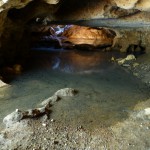
Rose told us of the sacredness of sites like this, a sanctity that needed to be preserved so that the spirits of the place would not be angered and harm the community. As strangers, for example, we needed to appease the spirits and protect ourselves. To do that, we took small pebbles, gathered sweat by rubbing them on our armpits and tossed them into a pool. Later, only the four women could visit a birthing cave, as that was “women’s business,” banned to men.
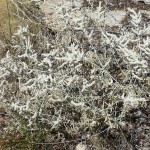
In the middle of the tour, we had tea and damper, fresh baked outback bread. Earlier we had passed a display of the stones traditionally used to hand-mill grains painstakingly gathered from the bush. So one of our party asked what was the flour she used. The one at the Coles grocery store, she responded plainly, to our chagrined laughter. By contrast, she related how women still use the soft, fluffy covering of the branches from one plant we passed, somewhat like the fluff on a pussy willow, to make pillows.
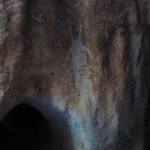
After a while, the discussion turned to more troubling matters. She told us of the personal impact of prejudice against her people. Her grandmother was removed from her family during the sad six decades of the “Stolen Generation,” when “half breed” children in particular were placed in white homes or institutions. Happily, her grandmother had been able to return to her family eventually. During the 1940s her cousins hid out in caves and darkened their skin with the ash of burnt tree trunks to avoid displacement. They needed the qualities of the figure drawn ages ago on a cave wall nearby, the blue-tongued lizard, a trickster figure often associated with fire that formed the local landscape in the dreamtime.
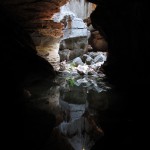
There seemed to be no enmity in all this – more a weary acceptance of a challenge that her people have survived, but continue to face. For her part, she was working hard to develop a portion of the land for a campground, to host foreigners and Australian descendants of those whose policies had caused such trouble to her community.
Perhaps then more can learn about the land and her people, growing mutual respect and understanding.
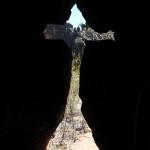
Yet, especially because of some recent strangers at the Mimbi Caves, we couldn’t help but think about an America that struggles similarly with the consequences of subjugation, prejudice and usurpation. For years, oddly, a statue of an American Indian stood amid the rocky cliffs, erected by two German women who managed to stay amid the caves unnoticed for over a year during the 1970s. Presumably these two did not upset the sanctity of the place as much as one might expect, perhaps because they were sensitive to what the local tribes had suffered.
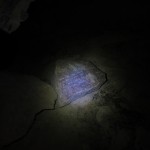
In addition to the statue, within a small cavity whose opening is shaped like a cross, they placed a sort of shrine commemorating the 19th century devastation of the Nez Perce tribe of native Americans, whom no blue-tongued lizard could help. There, on a small stone, the Germans had scratched the famous quote from the tribe’s Chief Joseph – “I will fight no more forever” – at his surrender to the U.S. Army.
(Also, for more pictures from Australia, CLICK HERE to view the slideshow at the end of the Australia itinerary page.)


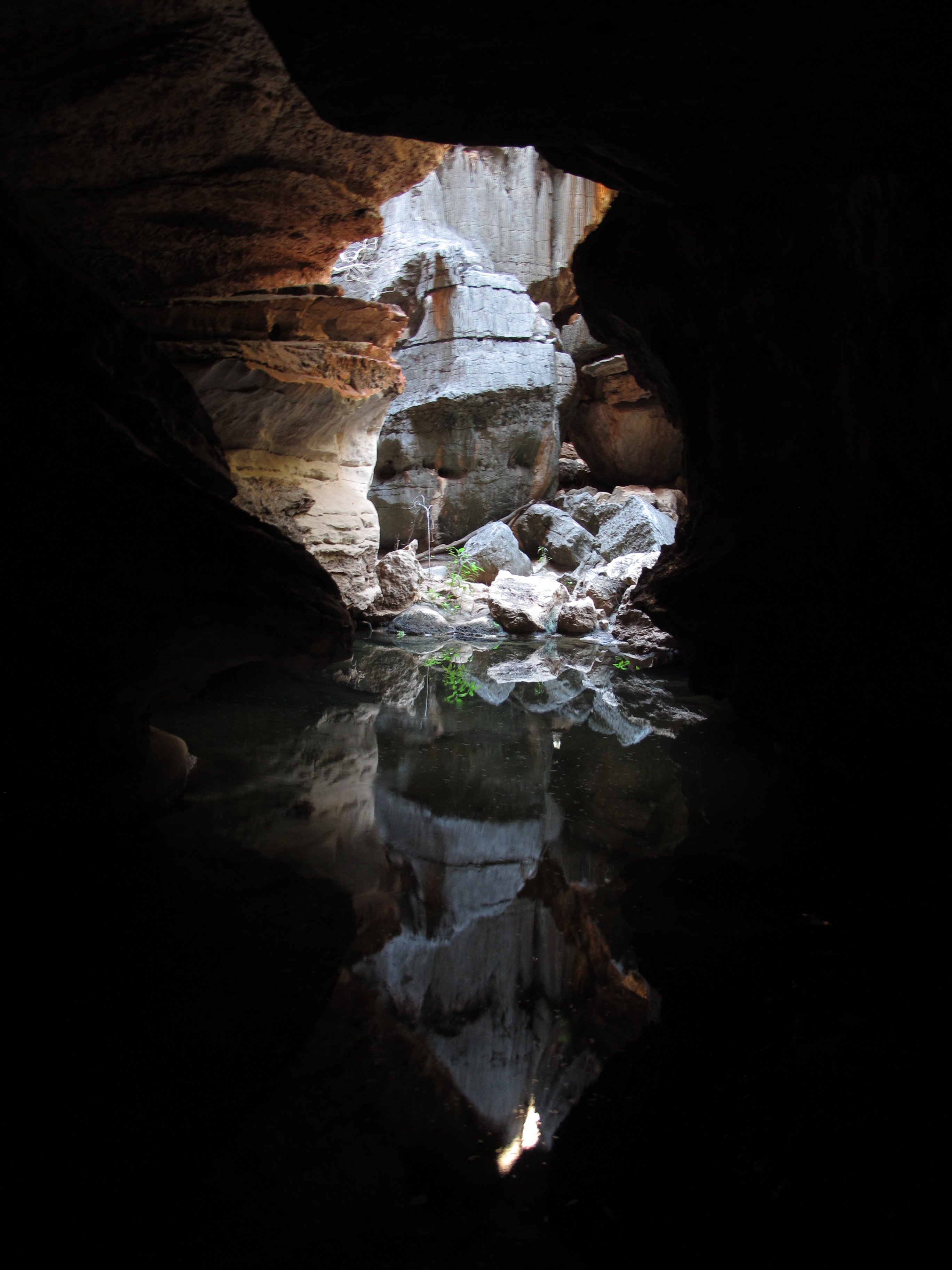
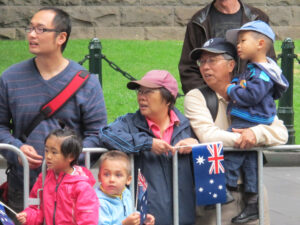

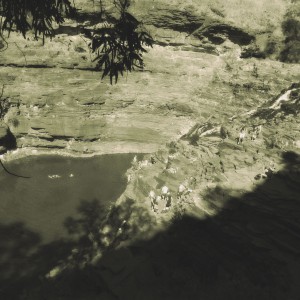
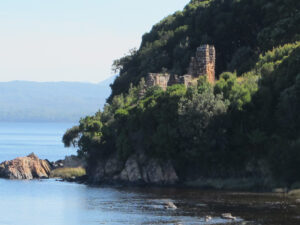
Wow -such interesting reading! Thanks!!
So glad you enjoyed it! We love sharing what we see.
Thanks for this balanced and well observed report. It contained some valuable information about visitor perception of the Mimbi Caves experience.
“For her part, she was working hard to develop a portion of the land for a campground, to host foreigners and Australian descendants of those whose policies had caused such trouble to her community.” Well, I can give you an update for that bit. The Gooniyandi people have started negotiations with the Department of Parks and Wildlife for a jointly managed national park. Government funding is available to establish the necessary infrastructure to make it an even nicer experience for the visitors (we hope).
Holger Woyt, Planning Officer, Department of Parks and Wildlife
We are pleased to hear this is moving forward.